|
|
 |
|
Calanoida ( Ordre ) |
|
|
|
Calanoidea ( Superfamille ) |
|
|
| |
| | | |
| Paracalanidae Giesbrecht, 1892 ( Calanoidea ) | | Syn.: | Paracalanina Giesbrecht,1892 (p.48);
Paracalaninae : Esterly, 1905 (p.138);
Eucalanidae : Rose, 1933 a (part., p.66).
Calocalanidae Bernard, 1958 (p.199); 1960 (n° 36-1ère rev., p.3); Corral Estrada, 1970 (p.108); Razouls, 1972 (Annexe: p.20: Rem.); Corral, 1972 (n°138, p.4); Björnberg, 1972 (p.21, 24); Björnberg & al., 1981 (p.624, Rem.); Bowman & Abele, 1982 (p.10); Razouls, 1982 (p.113); Sazhina, 1985 (p.112, Nauplius); Madhupratap & al., 1996 (p.863, Table 5: %/copepods); Mulyadi, 2004 (p.179)
Mecynoceridae Andronov, 1973 b (p.1721); 1974 a (p.1005); Razouls, 1982 (p.101); Bowman & Abele, 1982 (p.10); Brodsky & al., 1983 (p.142, 147, 216); Mauchline, 1987 (p.722, 740, cuticular pores); Hiromi, 1987 (p.147, 153, Rev.); Nishida, 1989 (p.174); Bradford-Grieve, 1994 (part., p.44, 71, Def., Rem.); Chihara & Murano, 1997 (p.833); Boxshall & Halsey, 2004 (p.136, Def.); Vives & Shmeleva, 2007 (p.907, Def.) | | Ref.: | Sars, 1901 a (1903) (p.16); Früchtl , 1924 b (p.34); Gurney, 1931 a (p.84); Oliveira, 1946 (p.458); Brodsky, 1950 (1967) (p.82, 107); Farran & Vervoort, 1951 c (n°35, p.3); Gonzalez & Bowman, 1965 (p.242); Andronov, 1970 (p.980 & suiv.); Björnberg, 1972 (p.24); Andronov, 1974 a (p.1005); Björnberg & al., 1981 (p.621); Razouls, 1982 (p.102); Bowman & Abele, 1982 (p.10); Brodsky & al., 1983 (p.143, 147, 213); Zheng Zhong & al., 1984 (1989) (p.231); Sazhina, 1985 (p.112, N); Nishida, 1989 (p.174, Rem.); Huys & Boxshall, 1991 (p.364); Madhupratap & al., 1996 (p.863, Table 5: %/copepods); Chihara & Murano, 1997 (p.844); Bradford-Grieve & al., 1999 (p.908, Genera Key); Barthélémy, 1999 a (p.30); Ohtsuka & Huys, 2001 (p.445, 461); Boxshall & Halsey, 2004 (p.14, 15; 49; 151: Def., Genera Key); Mulyadi, 2004 (p.170, Def.); Vives & Shmeleva, 2007 (p.913, part. Genera Key); Bradford-Grieve, 2008 (p.59, 60: emend.,Rem.); Blanco-Bercial & al., 2011 (p.103, Table 1, Fig.2, 3, 4, Biol. mol, phylogeny); Cornils & Blanco-Bercial, 2013 (p.861, Phylogeny, molecular analysis); S.Y. Moon & al. (2014, p.29, 44: Genera Key , emended from Boxshall & Halsey, 2004); Laakmann & al., 2019 (p.330, fig. 2, 3, phylogenetic relationships); Hirai & al., 2020 (p.1, Fig.4: metabarcoding, Fig.8: OTUs distribution patterns)
Bradford-Grieve J.M., (2002 onwards). Key to calanoid copepod families. Version 1 : 2 oct 2002. http://www.crustacea.net/crustace/calanoida/index.htm  | | Rem.: | La création de la famille des Calocalanidae à partir du genre Calocalanus , placée initialement par Giesbrecht (1892, p.49) parmi les Paracalanidae, est sujette à controverse. Björnberg s'appuyant sur la morphologie du nauplius confirme le bien-fondé de cette création. Fleminger (1967 a), Andronov (1970, p.980 & suiv.), Hiromi (1987, p.147, 153, Rem.), Bradford-Grieve (1994) incluent cette famille parmi les Paracalanidae, mais non Bowman & Abele (1982) ni Huys & Boxshall (1991). En 2004, Boxshall & Halsey (2004, p.153) incluent les Calocalanidae dans les Paracalanidae. Bradford-Grieve, 2008 (p59) considère la famille Mecynoceridae Andronov, 1973 comme un synonyme junior de Paracalanidae Gissbrecht, 1893.
After Madhupratap & al. (1996), la famille des Calocalanidae représente de 0,1 à 2,5 % des copepodes selon la saison dans la couche de mélange des eaux océaniques de la région ouest de l'Inde (Mer Arabe), et les autres formes de Paracalanidae de 17,5 à 24 %.
2 G : Calocalanus, Ischnocalanus. Ce dernier genre est considéré comme un synonyme de Calocalanus.
6 G.: Acrocalanus, Bestiolina, Calocalanus, Delibus, Paracalanus, Parvocalanus. | 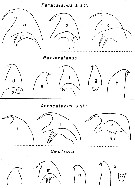 issued from : J. Hiromi in Bull. Coll. Agr. & Vet. Med., Nihon Univ., 1987, 44. [p.152, Fig.2]. Structure of rostrums in species female of Paracalanus, Acrocalanus and Bestiolina.. Comparison of similarities and differences. a: Paracalanus aculeatus; b, P. denudatus; c, P. parvus; d, Parvocalanus crassirostris; e, P. dubia; f, P. elegans; g, P.latus; h, P. scotti; i, Acrocalanus gibber; j, A. gracialis; k, A. monachus; l, Bestiolina inermis; m, B. sp.; n, B. sinicus; o, B. ceylonica. e, l: after Sewell, 1912; g,o: after Andronov, 1972; h: after Vervoort, 1963; n: after Shen & Lee, 1966. |
 issued from : J. Hiromi in Bull. Coll. Agr. & Vet. Med., Nihon Univ., 1987, 44. [p.150-151, Table 1]. Comparative list of the diagnostic characters in genera of the family Paracalanidae (rewritten from Andronov, 1973). 1: Number of segments of A1 (female); 2: Number of segments of A1 (male); 3: 8th and 9th segments of A1; 4: Rostrum; 5: Number of urosomites segments (female); 6: Keel-shaped hump on cephalothorax (male); 7: Positions of genital opening (male); 8: Internal seta on basipod 2 of P1; 9: External spinules on exopodal segment 3 of P2-P4; 10: Number of external spines on exopodal segment 3 of P2-P4; 11: Number of setae on endopodal segment 2 of P2-P4; 12: Number of setae on endopodal segment 3 of P2-P4; 13: Number of segments of P5 female (left/right); 14: Number of segments of P5 male (left/right). In Table, corrected Delius = Delibus and Bestiola = Bestiolina. |
 Issued from : G.A. Boxshall & S.H. Halsey in An Introduction to Copepod Diversity. The Ray Society, 2004, No 166, Part. I. [p.151]. Armature formula of swimming legs P1 to P4. Nota: Setation sometimes reduced. Ornamentation of spinule rows typically present on surface of 2nd and 3rd endopodal segments of P1 to P4, and sometimes on 2nd exopodal segments. P5 female fused medially to form transverse protopodal plate; uniramous; 2 to 4-segmented, often armed with setae distally; may be rudimentary or absent, as in Acrocalanus. Male P5 uniramous, highly asymmetrical; right leg short, 2 to 4-segmented; right leg sometimes rudimentary, or absent, as in Delius; left leg elongate, 5-segmented and slightly prehensile. Eggs released into water. |
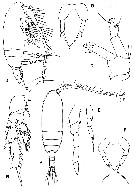 Issued from : G.A. Boxshall & S.H. Halsey in An Introduction to Copepod Diversity. The Ray Society, 2004, No 166, Part. I. [p.152, Fig.33]. Paracalanidae. A, Paracalanus parvus habitus female (dorsal view); B, female P5; C, Paracalanus indicus male A2; D, Paracalanus aculeatus habitus male (lateral view); E, male P5; F, female P5; G, Acrocalanus andersoni female second leg (P2) [non third leg) (posterior view). [Sars, 1901: A-B; Bradford-Grieve, 1994: C; Vervoort, 1963: D-F; Bowman, 1958: G]. | | | | | (1) Acrocalanus Giesbrecht, 1888 | |
| | Ref.: | Giesbrecht, 1892 (p.48, 171); Giesbrecht & Schmeil, 1898 (p.25, spp. Key); Wolfenden, 1905 (p.999); A. Scott, 1909 (p.28); Sewell, 1912 (p.336); 1929 (p.78); Mori, 1937 (1964) (p.30, spp. Key); Dakin & Colefax, 1940 (p.93); Vervoort, 1946 (p.132); Sewell, 1947 (p.52); Tanaka, 1956 c (p.371); Bowman, 1958 (p.121, Rem); Gonzalez & Bowman, 1965 (p.243); Corral Estrada, 1970 (p.100); Andronov, 1973 b (p.1720, Rem.); Razouls, 1982 (p.108); Zheng Zhong & al., 1984 (1989) (p.232, spp. Key); Mauchline, 1988 (p.721); Hiromi, 1987 (p.151, 152, 154); Chihara & Murano, 1997 (p.845); Bradford-Grieve, 1994 (p.46, Def.); Mauchline, 1998 (p.77); Bradford-Grieve & al., 1999 (p.909: clé spp.); Boxshall & Halsey, 2004 (p.153); Mulyadi, 2004 (p.172, Def.); Vives & Shmeleva, 2007 (p.915, spp. Key); S.Y. Moon & al., (2014, p.29, 44: Genus key) | | Rem.: | Type: Acrocalanus longicornis Giesbrecht,1888. Total: 5 spp. | | Remarques sur les dimensions et le sex-ratio: | | The mean female size is 1,135 mm (n = 10; SD = 0.3436), and the mean male size is 1.043 mm (n = 10; SD = 0.2593). The size ratio (Male: Female) is 0.925 ( n = 5; SD = 0.1215). The sex ratio is 1. |  issued from : C.T. Achuthankutty, N. Ramaiah & G. Padmavati in Pelagic biogeograpgy ICoPB II. Proc. 2nd Intern. Conf. Final report of SCOR/IOC working group 93, 9-14 July 1995. Workshop Report No. 142, Unesco, 1998. [p.8, Fig.6]. Salinity ranges for Acrocalanus spp. in coastal and estuarine waters of Goa (India). Shaded area indicates the range of higher abundance. |
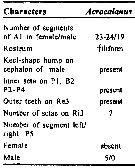 issued from : Mulyadi in Published by Res. Center Biol., Indonesia Inst. Sci. Bogor, 2004. [p.171, Table 2]. After Hiromi, 1987. Diagnostic characters in the genus Acrocalanus. Nota: Compare with the allied genera Bestiolina, Delius, Paracalanus, Parvocalanus. | | | | | Bestiola Andronov, 1972 | | Syn.: | Acrocalanus (part.) | | Ref.: | Andronov, 1972 a (p.290) | | Rem.: | type: Bestiola zeylonica Andronov ,1972. Andronov (1972 a) définit le genre Bestiola lors de la description d'une forme (B. zeylonica ) qui s'apparente à 3 espèces d'Acrocalanus (A. inermis , A. similis , A. sinicus).
Le genre Bestiola se distingue d'Acrocalanus par un rostre raccourci chez le (M) et la (F), une P5 rudimentaire chez la (F) ainsi que la rame droite chez le (M), l'absence de dents sur le bord externe des art. 2 et 3 de P2 à P4; Ri3 de P3 et P4 avec 6 s.. Dans ces conditions les 3 espèces précitées classées parmi les Acrocalanus appartiennent au nouveau genre Bestiola.
Andronov (1991, p.133) change ce nom déjà préoccupé en Bestiolina.
| | | | (2) Bestiolina Andronov, 1991 | |
| | Syn.: | Bestiola Andronov, 1972 a (p.290); 1973 b (p.1720, Rem.) (nom. preoc.); Hiromi, 1987 (p.147, 151, 152, 154); Mulyadi, 2004 (p.178, Def.) | | Ref.: | Andronov, 1991 (p.133: Rem.); Razouls, 1993 (p.308); Bradford-Grieve, 1994 (p.51, Déf.); Chihara & Murano, 1997 (p.846); Mauchline, 1998 (p.77); Boxshall & Halsey, 2004 (p.153); Moon & al, 2010 (p.32, Rem., Key F.); Moon & al., 2010 (p.39, key of females); S.Y. Moon & al., (2014, p.29, 44: Genus key); Dorado-Roncancio & al., 2019 (p.11: Rem., Key F). | | Rem.: | type: Bestiola zeylonica Andronov,1972. Total: 10 spp. + 1 indet. | | Remarques sur les dimensions et le sex-ratio: | | The mean female size is 0.892 mm (n = 13; SD = 0,1327), and the mean male size is 0.849 mm (n = 13; SD = 0.1086). The size ratio male: female is 0.945 (n = 5; SD = 0.0272). The sex ratio (female: male) is 1. |  issued from : S.Y. Moon, W. Lee & H.Y. Soh in Proc. Biol. Soc. Washington, 2010, 123 (1). [p.45, Fig.9]. Distribution géographique de Bestiolina. carré noir: B. similis; carré blanc: B. amoyensis; cercle blanc: B. inermis; cercle noir: B. sinica; triangle blanc: B. zeylonica; triangle noir: B. arabica; étoile blanche: B. coreana. |
 issued from : S.Y. Moon, W. Lee & H.Y. Soh in Proc. Biol. Soc. Washington, 2010, 123 (1). [p.45, Fig.9]. Schematic illustration of world-widezoogeographical distribution of genus Bestiolina. Black square: B. similis; white square: B. amoyensis; white circle: B. inermis; black circle: B. sinica; white triangle: B. zeylonica; black triangle: B. arabica; white star: B. coreana. According to Moon & al. (2010, p.43) these distributional patterns show that the speciation of Bestiolina could have originated from the Indo-Malayan region. In particular, the radiation of the Indo-Pacific species of bestiolina could have been brought about by changes in the inflow of fresh water from East and Southeast Asia during the Pleistocene glacial periods, as hypothesized for the speciation mechanisms of the Tortanus subgenus, Eutortanus (Ohtsuka & al., 1992; Ohtsuka & Reid, 1998). The testing of this hypothesis awaits a more detailed knowledge of Bestiolina, particularly the molecular variability. |
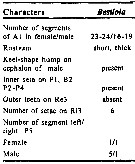 issued from : Mulyadi in Published by Res. Center Biol., Indonesia Inst. Sci. Bogor, 2004. [p.171, Table 2]. After Hiromi, 1987. Diagnostic characters in the genus Bestiola (= Bestiolina). Nota: Compare with the allied genera Acrocalanus, Delibus, Paracalanus, Parvocalanus. |
 Issued from : F.G. Vieira-Menezes et al. in Marine Biodiversity, 2021, 51. |
 Issued from : F.G. Vieira-Menezes et al. in Marine Biodiversity, 2021, 51. | | | | | (3) Calocalanus Giesbrecht, 1888 | |
| | Syn.: | Leptocalanus Bernard, 1958 a (p.198); Ischnocalanus Bernard, 1963 b (p.160, Rem.); Corral, 1970 (p.110); Corral, 1972 (n°138, p.5, 6, key for F); Razouls, 1972 (p.21: Rem.); 1982 (p.121); 1993 (p.308); Bradford-Grieve (1994, p.52) considère ce genre comme synonyme de Calocalanus; Mauchline, 1998 (p.77, 78) | | Ref.: | Giesbrecht, 1892 (p.49, 175); Giesbrecht & Schmeil, 1898 (p.26); Wheeler, 1901(p.169); Van Breemen, 1908 a (p.22); A. Scott, 1909 (p.30); Sewell, 1929 (p.88); Wilson, 1932 a (p.39); Rose, 1933 a (p.75, spp. Key); Mori, 1937 (1964) (p.33); Vervoort, 1946 (p.138); Farran & Vervoort, 1951 (n°36, p.3); Tanaka, 1956 c (p.377); Bernard, 1958 a (p.185); 1960 (n°36, first Rev., p.3); Schmeleva, 1965 (p.13, clé des F); Andronov, 1973 b (p.1720, Rem.); Corral Estrada, 1970 (p.109); Razouls, 1972 (Annexe: p.20, Rem.); Corral, 1972 (n°138, p.4, 5, Key for F.); Gardner & Szabo, 1982 (p.163); Razouls, 1982 (p.113); Zheng Zhong & al., 1984 (1989) (p.233, spp. Key); Hiromi, 1987 (p.147, 151, 154, Rev.); Razouls, 1993 (p.308); Bradford-Grieve, 1994 (p.46, 52, Déf.); Chihara & Murano, 1997 (p.749); Mauchline, 1998 (p.77); Bradford-Grieve & al., 1999 (p.877, 909: clé spp.); Boxshall & Halsey, 2004 (p.153); Vives & Shmeleva, 2007 (p.919, spp. Key); S.Y. Moon & al., (2014, p.29, 44: Genus key) | | Rem.: | Type: Calanus pavo Dana,1849; 1852. Total: 50 spp. | | Remarques sur les dimensions et le sex-ratio: | | Les espèces de Calocalanus sont de petites tailles. Les femelles ont une longueur moyenne de 0,669 mm (n= 48; S = 0,186; Cv = 0,278) pour 48 espèces sur 50. 5 sont supérieures au mm et 7 inférieures ou égales à 0,5 mm, les formes restantes étant intermédiaires à ces deux valeurs. Le rapport des dimensions entre les mâles et les femelles (établi à partir de 19 espèces) est de 0,832, soit 83,2 % (S = 9,264; Cv = 0,111). Ces espèces sont susceptibles de passer à travers les mailles des filets. Ceci explique sans doute le rapport entre les sexes : 50 femelles contre seulement 20 mâles connus F/M= 2,5, comme les nombreux cas d'endémisme chez des formes essentiellement épipélagiques. | | | | (4) Delibus Andronov, 1972 | |
| | Syn.: | Delius Andronov, 1972 b (p.597); 1973 b (p.1720, Rem.); Razouls, 1982 (p.112); Hiromi, 1987 (p.147, 151, 154); Razouls, 1993 (p.308); Bradford-Grieve, 1994 (p.66, Def.); Chihara & Murano, 1997 (p.846); Mauchline, 1998 (p.77); Bradford-Grieve & al., 1999 (p.910: spp. Key); Boxshall & Halsey, 2004 (p.153);
Andronovius Özdikmen, 2008 (p.266: Rem.) | | Ref.: | Vives & Shmeleva, 2007 (p.963, 1127: Rem.); S.Y. Moon & al., (2014, p.29, 44: Genus key) | | Rem.: | type: Paracalanus nudus Sewell,1929. Total: 2 spp. | | Remarques sur les dimensions et le sex-ratio: | | The mean female size is 0.550 mm, and the mean male size is 0.45 mm. The size ratio male: female is 0.82. The sex ratio (female: male) is 1. | 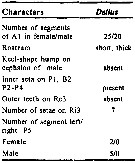 issued from : Mulyadi in Published by Res. Center Biol., Indonesia Inst. Sci. Bogor, 2004. [p.171, Table 2]. After Hiromi, 1987. Diagnostic characters in the genus Delius (= Delibus). Nota: Compare with the allied genera Acrocalanus, Bestiolina, Paracalanus, Parvocalanus. | | | | | | Ref.: | Andronov, 1972 b (p.597); 1973 b (p.1720, Rem.); Razouls, 1982 (p.112); Hiromi, 1987 (p.147, 151, 154); Razouls, 1993 (p.308); Bradford-Grieve, 1994 (p.66, Déf.); Chihara & Murano, 1997 (p.846); Mauchline, 1998 (p.77); Bradford-Grieve & al., 1999 (p.910: clé spp.); Boxshall & Halsey, 2004 (p.153) | | Rem.: | type: Paracalanus nudus Sewell,1929. Le nom de genre est modifié en Delibus in Vives & Shmeleva, 2007 (p.963), Delius: nom de genre d'un insecte. | | | | (5) Mecynocera I. C. Thompson, 1888 | |
| | Syn.: | Leptocalanus Giesbrecht,1888; Dolichocerea Bernard,1963 | | Ref.: | Giesbrecht, 1892 (p.47, 160); Giesbrecht & Schmeil, 1898 (p.23); Wheeler, 1901 (p.167); Esterly, 1905 (p.137); van Breemen, 1908 a (p.19); A. Scott, 1909 (p.25); Wilson, 1932 a (p.36); Rose, 1933 a (p.71); Mori, 1937 (1964) (p.28); Farran & Vervoort, 1951 b (n°34, p.3); Carvalho, 1952 a (p.142); Andronov, 1970 (p.980, Rem.); Corral Estrada,1970 (p.110, 111, 139, Rem.); Razouls, 1972 (Annexe: p.21: Rem.); Corral, 1972 (n°138, p.5); Andronov, 1973 b (p.1719, 1720); Razouls, 1982 (p.101); Mauchline, 1988 (p.722); Hiromi, 1987 (p.147, 150); Razouls, 1993 (p.308); Bradford-Grieve, 1994 (p.70, Def.); Chihara & Murano, 1997 (p.833); Mauchline, 1998 (p.77); Bradford-Grieve & al., 1999 (p.911); Boxshall & Halsey, 2004 (p.136); Vives & Shmeleva, 2007 (p.908); Bradford-Grieve, 2008 (p.59, Rem.: species transferred to Pacacalanidae family); Cornils & Blanco-Bercial, 2013 (p.861, fig.3, 5, molecular analysis, morphology phylogenetic); S.Y. Moon & al., (2014, p.29, 44: Genus key) | | Rem.: | Type: Mecynocera clausii I.C. Thompson,1888 . 1 sp.: | | Remarques sur les dimensions et le sex-ratio: | | Le rapport des tailles mâle/femelle pour les 9 cas où des mesures pour les deux sexes ont été réalisées est de 0, 968 (n = 9; SD = 0.0788), valeur très proche du calcul global à partir de toutes les mesures mondiales: 0.950. | | | | (6) Paracalanus Boeck, 1864 | |
| | Syn.: | Calanus (part.) : Claus,1863; Piezocalanus Grandori, 1912 (p.98); Pesta, 1920 (p.502) | | Ref.: | Giesbrecht, 1892 (p.48, 164); Giesbrecht & Schmeil, 1898 (p.23, spp. Key); Wheeler, 1901 (p.168); Sars, 1901 a (1903) (p.17); Esterly, 1905 (p.139); van Breemen, 1908 a (p.20); A. Scott, 1909 (p.26); Sewell, 1912 (p.336); Esterly, 1924 (p.85); Früchtl, 1924 b (p.34); Sewell, 1929 (p.61, Rem.: 2 groups); Wilson, 1932 a (p.37); Rose, 1933 a (p.72); Mori, 1937 (1964) (p.29); Vervoort, 1946 (p.126); Davis, 1949 (p.17); Brodsky, 1950 (1967) (p.108); Farran & Vervoort, 1951 c (n°35, p.3); Carvalho, 1952 a (p.142); Tanaka, 1956 c (p.367); Vervoort, 1962 a (p.394, Rev., spp. Key); Ramirez, 1966 (p.9); Bowman, 1971 (p.18, Rem.); Andronov, 1973 b (p.1720, Rem.); 1977 (p.154); Bradford, 1978 (p.133, Rem.); Razouls, 1982 (p.102); Brodsky & al., 1983 (p.213); Zheng Zhong & al., 1984 (1989) (p.231, spp. Key); Ambler, 1986 a (p.957, ingestion rate vs food concentration: nauplius-copepodids-adults); Hiromi, 1987 (p.147, Rev., Table); Mauchline, 1988 (p.720); Ferrari, 1992 (p.392, tab.3); Razouls, 1993 (p.308); Bradford-Grieve, 1994 (p.66, Déf.); Chihara & Murano, 1997 (p.844); Mauchline, 1998 (p.77); Bradford-Grieve & al., 1999 (p.910: spp. Key, Rem.); Boxshall & Halsey, 2004 (p.153); Mulyadi, 2004 (p.170, Def., Table 2); Vives & Shmeleva, 2007 (p.964, spp. Key); Kesarkar & Anil, 2010 (Rem.: p.6); S.Y. Moon & al., (2014, p.29, 41: 44: Rem., Genus key) | | Rem.: | Type: Calanus parvus Claus,1863. Total: 12 spp.+ 1 variété + 2 indet. | | Remarques sur les dimensions et le sex-ratio: | | The mean female size is 0.851 mm (n = 26; SD = 0.2238), and the mean male size is 0.895 mm (n = 14; SD = 0.3200). The size ratio (Male: Female) is 0.981 (n = 9; SD = 0.0698), being noticeably the same size. Le sex ratio (Female: Male) is 1.55. |  issued from : C.T. Achuthankutty, N. Ramaiah & G. Padmavati in Pelagic biogeograpgy ICoPB II. Proc. 2nd Intern. Conf. Final report of SCOR/IOC working group 93, 9-14 July 1995. Workshop Report No. 142, Unesco, 1998. [p.8, Fig.6]. Salinity ranges for Paracalanus spp. in coastal and estuarine waters of Goa (India). Shaded area indicates the range of higher abundance. |
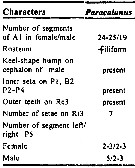 issued from : Mulyadi in Published by Res. Center Biol., Indonesia Inst. Sci. Bogor, 2004. [p.171, Table 2]. After Hiromi, 1987. Diagnostic characters in the genus Paracalanus. Nota: Compare with the allied genera Acrocalanus, Bestiolina, Delibus, Parvocalanus. |
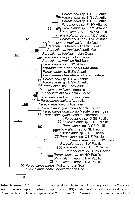 Issued from : F.G. Vieira-Menezes et al. in Marine Biodiversity, 2021, 51. |
 Issued from : F.G. Vieira-Menezes et al. in Marine Biodiversity, 2021, 51. | | | | | (7) Parvocalanus Andronov, 1970 | |
| | Ref.: | Andronov, 1970 (p.984, Def.); 1973 b (p.1720, Rem.); Björnberg, 1981 (comm. pers.: Genus uncertain); Razouls, 1982 (p.110); Hiromi, 1987 (p.147, Rem.); Razouls, 1993 (p.308); Bradford-Grieve, 1994 (p.69, Def.); Mauchline, 1998 (p.77); Bradford-Grieve & al., 1999 (p.909, 911: spp. Key); Boxshall & Halsey, 2004 (p.153); Mulyadi, 2004 (p.176, Def.); Vives & Shmeleva, 2007 (p.974); Kesarkar & Anil, 2010 (Rem.: p.6); S.Y. Moon & al., (2014, p.29, 41: Rem. 43-44: emended, Genus key, spp. Key) | | Rem.: | Type: Paracalanus crassirostris Dahl,1894. Total: 6 spp. (si le genre est maintenu). | | Remarques sur les dimensions et le sex-ratio: | | The mean female size is 0.631 mm (n = 10; SD = 0.2210), and the mean male size is 0.580 mm (n = 6; SD = 0.2909). The size ratio (Male: Female) is 0.31 (n = 4; Sd = 0.2909). The sex ratio (Female: Male) is 1.5. |  issued from : Mulyadi in Published by Res. Center Biol., Indonesia Inst. Sci. Bogor, 2004. [p.171, Table 2]. After Hiromi, 1987. Diagnostic characters in the genus Parvocalanus. Nota: Compare with the allied genera Acrocalanus, Bestiolina, Delibus, Paracalanus. |
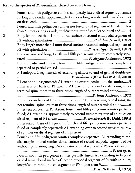 Issued from : S.Y. Moon, S.-H. Youn & H.Y. Soh in ZooKeys, 2014, 456. [p.45]. Key to the species of Parvocalanus (adult female only). | | | | | | | | | |
|
|
 Toute utilisation de ce site pour une publication sera mentionnée avec la référence suivante : Toute utilisation de ce site pour une publication sera mentionnée avec la référence suivante :
Razouls C., Desreumaux N., Kouwenberg J. et de Bovée F., 2005-2025. - Biodiversité des Copépodes planctoniques marins (morphologie, répartition géographique et données biologiques). Sorbonne Université, CNRS. Disponible sur http://copepodes.obs-banyuls.fr [Accédé le 03 décembre 2025] © copyright 2005-2025 Sorbonne Université, CNRS
|
|
 |
 |













